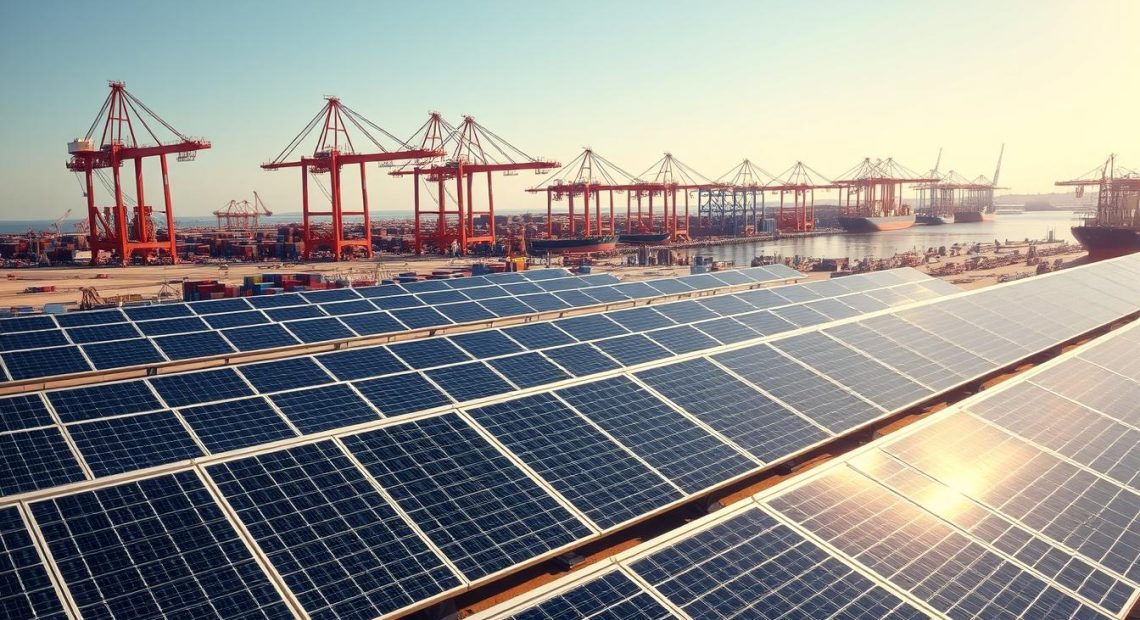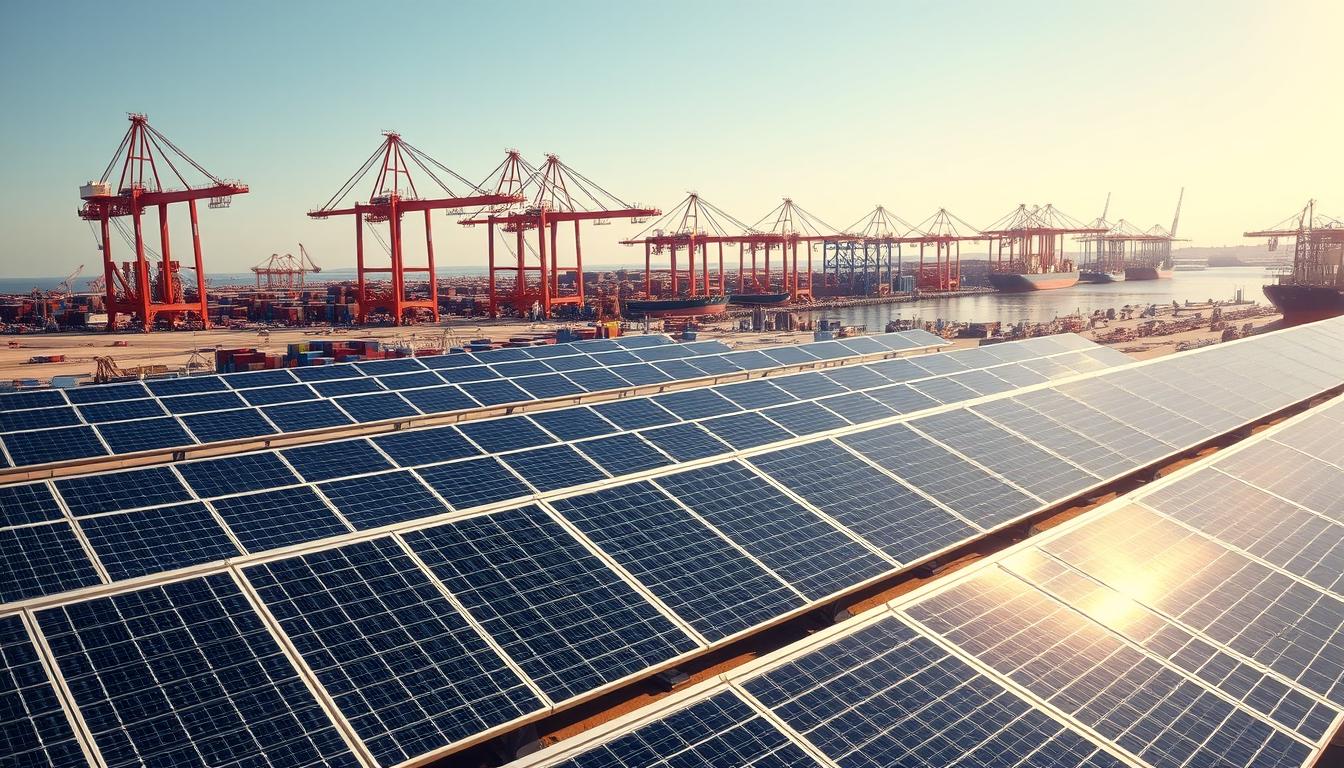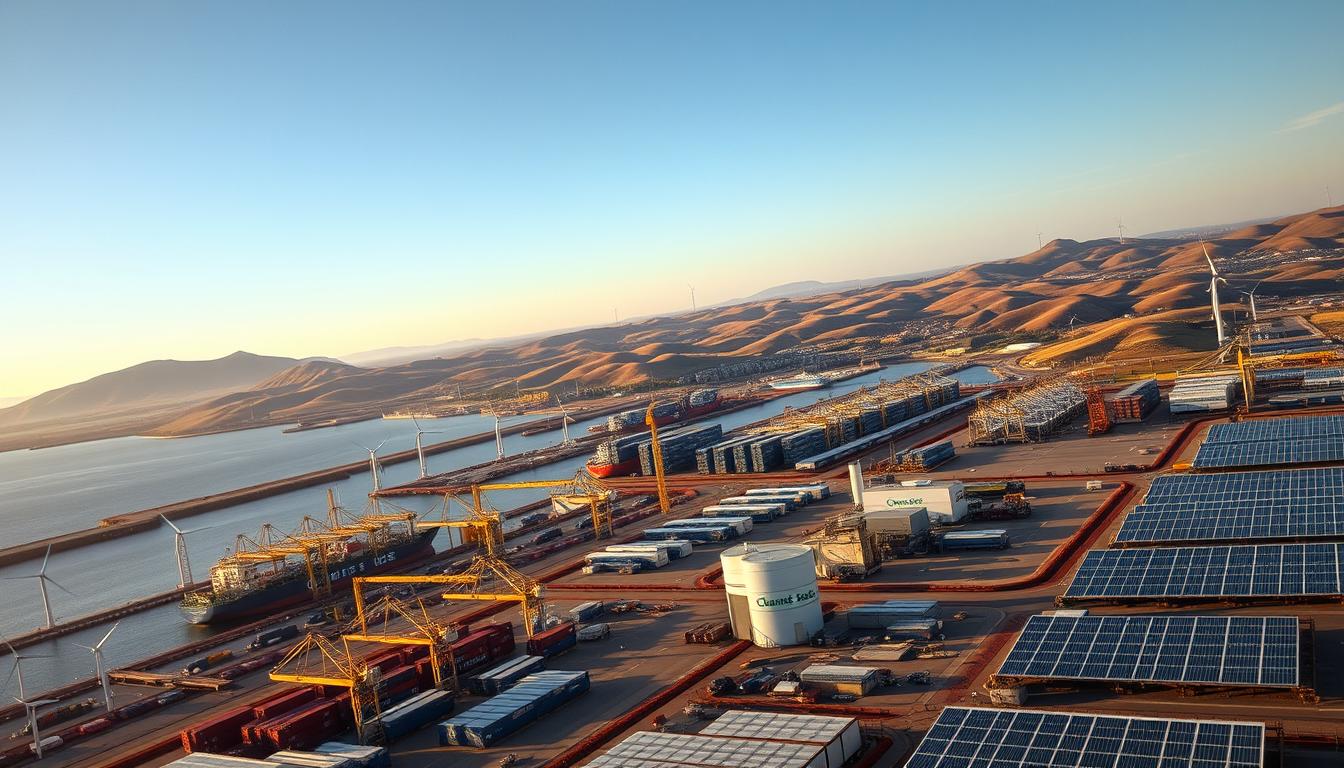Winds of Change: Seaports Embrace Wind and Solar Power for a Greener Future

The maritime industry is moving towards a greener future. British seaports are leading this change by using wind and solar power. The UK has the world’s largest offshore wind capacity, over 10 GW in 2023.
Renewable energy is becoming key for modern seaports. It offers a cleaner option compared to traditional power. Using sustainable electricity systems is good for the environment and also smart for business.
Wind and solar power are leading the maritime change. The cost of wind power has dropped by 55% and solar by 85% in the last decade. These technologies are now more affordable than ever.
This change is not only reducing carbon emissions but also creating jobs. Solar installers and wind turbine technicians are in high demand.
We will look into how British seaports are tackling the challenges of renewable energy. We will also see the bright future ahead for sustainable port operations.
Key Takeaways
- The UK leads in offshore wind capacity with over 10 GW operational
- Wind and solar power costs have decreased significantly, making them more viable
- Seaports are actively integrating sustainable electricity generation systems
- Renewable energy in ports offers both environmental and economic benefits
- The transition is creating new job opportunities in the renewable energy sector
- British seaports are at the forefront of maritime sustainability efforts
Introduction to Seaport Energy Initiatives
Seaports are turning to green energy to meet growing energy needs and cut carbon emissions. They handle 40% of energy cargo and cause up to 5% of global emissions. Moving to renewable energy is key.
The Rise of Renewable Energy
Renewable energy is expected to lead in new power generation. It will make up 60% of all new capacity by 2040. Seaports are leading this change, finding new ways to use wind and solar power.
Wind and Solar Technologies Overview
Wind turbines are now common at ports. A wind farm can produce about 30 megawatts from ten turbines. The Hornsea One project, 120 km off Yorkshire, has 174 turbines over 407 square kilometres. It powers over one million UK homes.
Photovoltaic systems are also showing great promise. The Port of Rotterdam aims to show over 1 GW of solar power. In Bahrain, the Khalifa Bin Salman Port is using 20,000 solar panels to aim for full solar power.
“Ports are positioned to serve as renewable energy hubs due to their access to major coastal load centres and offshore resources.”
These green energy steps cut emissions and save money. The Port of Long Beach, for example, saved up to $1.2 million. This was from solar panels that reduced electricity use by 50%.
Importance of Sustainability in Seaports
Seaports are key to global trade, but they harm the environment. There’s a big push to make them more sustainable. This is to cut down on carbon emissions and use cleaner energy.
Environmental Impact of Traditional Energy Sources
Ports mainly use fossil fuels, causing pollution in the air and water. Shipping is responsible for about 2.5% of global carbon emissions. This shows we need to switch to cleaner energy like solar and wind in ports.
Regulatory Pressures Driving Change
The European Union is watching how well ports follow green practices. This pressure is making ports use cleaner technologies. For example, the John Good Group’s maritime division has gone carbon neutral, showing what’s possible.
The Future of Global Trade and Sustainability
The future of seaports is about growing the economy while protecting the environment. Investing in green port infrastructure can make operations better and less harmful. For example:
- Electrifying ships
- Using smart tech in logistics
- Building with sustainable materials
- Creating green spaces around ports
These steps are making the maritime industry more sustainable. As ports change, they’ll play a big part in the Energy Transition and reducing carbon footprints. This will shape the future of global trade.
Wind Power Adoption in British Seaports
British seaports are turning to wind power as a clean energy option. They are leading the way in making electricity more sustainable. The UK plans to increase offshore wind to 60 GW by 2030, showing its big role in renewable energy.
Case Studies: Successful Wind Energy Projects
Many UK ports have made wind energy work well. In 2024, wind power became the top energy source in the UK, making up 30% of electricity. This shows how well wind turbines can work in seaports.
Innovative Wind Turbine Designs
UK seaports are leading in wind turbine innovation. They have over 11,000 turbines with a total power of 30 gigawatts. Offshore farms in the UK get 40-50% capacity, beating onshore ones.
Advanced designs like the GE Haliade-X can make up to 14 MW. That’s enough to power about 16,000 homes.
Community Engagement and Support
Wind power projects in British seaports need community support. Local backing helped hit records like 21.6 GW on January 10, 2023. This support made wind power the biggest renewable energy source in the UK, making over a quarter of the country’s electricity.
- Wind power generated 32.4% of UK electricity in the first quarter of 2023
- The UK has over a third of Europe’s total offshore wind resource
- Scotland aims for 11 GW of offshore wind capacity by 2030
As British seaports keep using wind power, they help make electricity sustainable. They also create jobs and boost the economy in coastal areas.
Solar Power Integration in Port Infrastructure
British seaports are turning to green energy, with solar power at the forefront. Photovoltaic systems are changing how ports work, providing clean energy for their daily tasks.
Benefits of Solar Energy for Seaports
Solar power brings many benefits to ports:
- Reduced operational costs
- Decreased carbon footprint
- Enhanced energy independence
- Improved public image
The Port of Los Angeles is a great example. It has installed nearly 3 MW of solar panels. They aim to use solar for one-sixth of their power needs.

Innovative Uses of Solar Technology
Ports are getting creative with solar technology:
- Rooftop installations on warehouses and terminals
- Solar-powered lighting for docks and parking areas
- Floating solar arrays in unused water spaces
The Port of Rotterdam is leading the way. It has 89 MWp of solar on roofs and plans for the biggest floating solar park in Europe.
Partnerships with Renewable Energy Providers
Seaports are teaming up with renewable energy firms for big solar projects. These partnerships help develop green energy solutions across ports. As solar power grows, ports are ready to embrace a sustainable future.
Financial Implications of Transitioning to Renewables
The shift to sustainable electricity in seaports comes with both hurdles and chances. As the maritime world moves to cleaner energy, knowing the financial side is key for port leaders.
Initial Investment versus Long-term Savings
Starting with renewables means big upfront costs. Yet, the long-term gains are huge. In 2023, 81% of new renewable energy was cheaper than old ways.
Solar PV costs were about 4 US cents per kilowatt hour. This is 56% less than fossil fuels and nuclear.
Funding Opportunities and Grants
Ports have many funding options for renewable projects. Spending on solar and wind has grown by over USD 300 billion in five years. Now, one-third of USD 1.8 trillion in clean energy investments for 2023 goes to renewables.
Cost-Benefit Analysis for Port Authorities
Ports must compare costs to savings. Renewable energy worldwide has saved up to USD 409 billion in fuel costs. Asia saved the most, USD 212 billion, from 2000-2010. Europe saved USD 88 billion.
- Storage project costs have dropped by 89% between 2010 and 2023
- To triple renewables by 2030, we need 11.2 terawatts of capacity
- 1,044 GW of new capacity must be added each year until 2030
While there are challenges, like grid delays and market ups and downs, the move to cheaper, cleaner energy is clear. Ports investing in renewables now are setting themselves up for a greener, more profitable future.
Job Creation and Economic Benefits
The move to green energy is creating lots of jobs and boosting the economy. Seaports are turning to renewable energy, cutting down on carbon emissions. They’re also opening up new job opportunities and helping local businesses grow.
Skills Development in Renewable Energy
Working with renewable energy needs skilled people. Seaports are working with schools to offer training in wind turbines, solar panels, and energy systems. This is preparing a new team of experts for the energy shift.
Local Economic Growth through Green Jobs
The renewable energy field is a big job creator. In 2023, there were 16.2 million jobs in this sector worldwide, up from 13.7 million the year before. In the UK, plans to increase offshore wind to 50 GW by 2030 could create 60,000 jobs and bring in billions in investment.
- Solar photovoltaic jobs reached 7.1 million globally in 2023
- Wind power employed 1.5 million people worldwide
- Biofuels sector provided 2.8 million jobs
These numbers show the big economic benefits of green energy. As seaports invest in renewable energy, they’re not just preparing for the future. They’re also helping to make their local economies stronger and more sustainable.
Challenges in Implementing Wind and Solar Power
The shift towards Wind and Solar Power in seaports is not easy. These energy sources have many benefits. But, they also come with their own set of challenges.
Technical and Logistical Hurdles
Seaports face big challenges when adding renewable energy. Setting up wind turbines and solar panels needs special tools and skills. Making the power grid work with these new sources is expensive and takes a lot of time.
Weather Dependency
Wind and Solar Power depend a lot on the weather. Changes in wind and sun can make energy production uneven. This makes it hard for seaports to have a steady power supply for their work.
Balancing Energy Needs with Sustainability
Seaports have to find a balance between their energy needs and being green. Renewable energy helps cut down on carbon emissions. But, it might not always be enough for the port’s energy needs. Mixing these new energy sources with old ones is a big challenge.
- Wind energy helps avoid 336 million metric tons of CO2 emissions annually
- Solar technology efficiency stands at 26% with a 20-25 year lifespan
- Transition to renewables requires substantial investment in infrastructure
Even with these challenges, the benefits of Wind and Solar Power in seaports are big. As technology gets better and new ideas come up, we can overcome these obstacles. This will lead to a greener, more sustainable future for maritime operations.
Policy Framework Supporting Renewable Energy
The UK government has set up a strong policy framework for renewable energy. This framework aims to boost green energy and cut carbon footprints in many areas. This includes seaports.
Government Incentives for Green Energy Investments
The government offers several incentives for green energy. Local planning authorities help approve projects up to 50 megawatts. For bigger projects, the Secretary of State for Energy is in charge, with local authorities helping out.

International Agreements on Climate Change
The UK is committed to global climate agreements. It wants all electricity to be low carbon by 2035. Renewable energy is key to this goal, changing the energy scene in seaports and other sectors.
Local Policies Promoting Sustainability
Local authorities are urged to find good spots for renewable energy. This makes it easier to get green energy projects approved. Community projects are also growing, helping to reduce carbon footprints.
“The UK government aims for all electricity to come from low carbon sources by 2035, with a projected increase in demand of 40-60%.”
These policies are changing the UK’s energy scene, mainly in seaports. They push for green energy and sustainable power. This is setting the stage for a greener future in maritime and other areas.
Innovations Paving the Way for Cleaner Ports
The maritime industry is seeing big changes with Clean Power Alternatives. These changes are making ports and ships cleaner. They are key to meeting global goals to cut down on pollution.
Smart Technologies in Energy Management
Ports are now using Distributed Energy Resources to manage power better. AI systems help control energy use, cutting down on waste. This makes ports more sustainable and meets their green goals.
Research and Development in Renewable Energy
New research is leading to cleaner energy options for ships and ports. Wind Turbines are getting better, like the ones in Hywind Scotland. They can work in deeper waters.
Other exciting ideas include:
- Wind-assisted propulsion systems like Flettner rotors and rigid sails
- Kite systems for catching winds high up
- Solar power for smaller boats and extra systems
- Wave and tidal energy for powering ports
These new energy solutions are saving money and helping meet green rules. Working together, ports, tech firms, and research groups are making the maritime world cleaner and greener.
The Role of Stakeholders in Transitioning Ports
The energy transition in ports needs everyone’s help. Port authorities, governments, and environmental groups are key players. They work together to make ports more sustainable and cut down on carbon emissions.
Engaging Port Authorities and Governments
Port authorities and governments lead the way in making maritime operations greener. The EU Green Deal wants to cut carbon emissions by 55% by 2030 and reach net zero by 2050. To get there, projects like PORTS 2030 are looking into new energy solutions.
- Onshore power supply
- Electrification of port equipment
- Renewable energy sources (wind, solar, tidal)
- Alternative fuels (LNG, hydrogen, ammonia)
Collaboration with Environmental Groups
Environmental groups offer important advice on making things greener. In the UK, the Offshore Renewables Joint Industry Programme (ORJIP) is studying how birds interact with offshore wind farms. They use cool tech like radar and cameras.
Most people in Ireland support offshore wind farms, with 93% not opposing them. This backing is key for the energy transition. Without it, big projects worth over £20 billion have been delayed or stopped in the past decade.
Getting everyone involved is essential for a successful energy transition in ports. Talking to local communities, businesses, and industry groups early on helps. Together, they can make a big difference in making ports more sustainable and reducing carbon emissions.
Future Trends in Seaport Energy Solutions
The maritime industry is moving towards a greener future. Seaports are at the forefront, adopting Renewable Energy Sources. They are looking for sustainable ways to meet their growing energy needs.
Predictions for Wind and Solar Energy Growth
Wind and Solar Power will be key in seaport energy’s future. Experts say renewable energy will make up 60% of new power by 2040. The Port of Rotterdam is leading with big solar projects, aiming for Europe’s biggest floating solar park.
Emerging Technologies on the Horizon
Seaports are exploring more than just wind and solar. New technologies are changing the energy scene:
- Hydrogen: Could meet up to 12% of global energy demand by 2050
- Small Modular Nuclear Reactors: The Belledune Port Authority plans a 1 GW zero-emission reactor
- Shore Power: Will grow as emissions rules get stricter
- Digital Twins: Improving how ports work and manage resources
These new technologies, along with automation and port electrification, are making seaports more efficient and green. As the industry moves towards a sustainable future, using a variety of Green Energy Solutions will be key to reaching net-zero carbon goals.
Conclusion: Navigating Towards a Sustainable Future
The energy shift in UK seaports is speeding up. It’s all about cutting carbon footprints and using green electricity. Wind power is set to meet 35% of global electricity needs by 2050. British ports are ready to tap into this.
The Hornsea One Project shows the UK’s dedication to clean energy. It has a massive 1,218-megawatt capacity.
Summary of Key Points
This article has shown how wind and solar power are changing seaport work. Moving to renewables helps the planet and boosts the economy. For example, wind energy could power 230 million homes by 2025, creating lots of jobs.
This change fits with the world’s goal. By 2030, renewables could power 65% of the world’s electricity.
The Path Forward for UK Seaports
UK seaports are set to lead in green practices. By investing in clean energy, they can save money and deal with energy price swings. The first cost might seem high, but there are ways to fund it, like green bonds and government help.
Looking to the future, going net-zero could bring 9 million new jobs by 2030. UK seaports will be key in making the maritime world greener and more sustainable.
FAQ
Why are seaports turning to wind and solar power?
What are the main benefits of using renewable energy in seaports?
How are British seaports leading in wind power adoption?
What innovative solar technologies are being used in ports?
What financial considerations are involved in transitioning to renewable energy?
How does the adoption of renewable energy create jobs in seaports?
What are the main challenges in implementing wind and solar power in seaports?
How are government policies supporting renewable energy adoption in seaports?
What role do stakeholders play in transitioning ports to renewable energy?
What future trends can we expect in seaport energy solutions?
Source Links
- https://www.climatecentral.org/news/wind-solar-power-101 – Wind and Solar Power 101 | Climate Central
- https://www.nationalgrid.com/stories/energy-explained/what-happens-when-wind-isnt-blowing-sun-isnt-shining – What happens when the wind isn’t blowing and the sun isn’t shining?
- https://ember-energy.org/latest-insights/why-wind-and-solar-are-key-solutions-to-combat-climate-change/ – Why wind and solar are key solutions to combat climate change | Ember
- https://porteconomicsmanagement.org/pemp/contents/part3/ports-energy-transition/ – Chapter 3.4 – Ports and Energy Transition | Port Economics, Management and Policy
- https://www.emerald.com/insight/content/doi/10.1108/mabr-12-2023-0083/full/pdf?title=renewable-energy-options-for-seaport-cargo-terminals-with-application-to-mega-port-singapore – MABR-12-2023-0083_proof 294..310
- https://netzero-events.com/can-ports-serve-as-renewable-energy-hubs/ – Can Ports Serve as Renewable Energy Hubs? – Future Bridge NetZero Events
- https://prosertek.com/blog/sustainability-in-ports/ – Sustainability in ports
- https://www.danshipping.co.uk/sustainability-in-ports-going-green/ – Sustainability in Ports: Going Green | DAN Shipping
- https://en.wikipedia.org/wiki/Wind_power_in_the_United_Kingdom – Wind power in the United Kingdom
- https://www.ref.org.uk/Files/performance-wind-power-uk.pdf – PDF
- https://www.newcivilengineer.com/latest/wind-power-largest-source-of-energy-generation-in-uk-for-first-time-ever-last-year-neso-stats-show-08-01-2025/ – Wind power largest source of energy generation in UK for first time ever last year, Neso stats show | New Civil Engineer
- https://splash247.com/solar-wind-and-nuclear-power-to-the-ports/ – Solar, wind and nuclear power to the ports – Splash247
- https://www.ricardo.com/en/news-and-insights/industry-insights/harnessing-the-power-of-community-islanding-and-microgrids-for-ports – Harnessing the power of community islanding and microgrids for ports
- https://www.iea.org/commentaries/financial-headwinds-for-renewables-investors-what-s-the-way-forward – Financial headwinds for renewables investors: What’s the way forward? – Analysis – IEA
- https://www.irena.org/News/pressreleases/2024/Sep/Record-Growth-Drives-Cost-Advantage-of-Renewable-Power – Record Growth Drives Cost Advantage of Renewable Power
- https://www.energy.gov/eere/job-creation-and-economic-growth – Job Creation and Economic Growth
- https://www.irena.org/Energy-Transition/Socio-economic-impact/Energy-and-Jobs – Energy and Jobs
- https://www.energy.gov/eere/wind/advantages-and-challenges-wind-energy – Advantages and Challenges of Wind Energy
- https://iee.psu.edu/news/blog/transitioning-renewable-energy-challenges-and-opportunities – Transitioning to renewable energy: Challenges and opportunities
- https://www.gov.uk/guidance/renewable-and-low-carbon-energy – Renewable and low carbon energy
- https://www.gov.uk/government/publications/national-policy-statement-for-renewable-energy-infrastructure-en-3/national-policy-statement-for-renewable-energy-infrastructure-en-3 – National Policy Statement for Renewable Energy Infrastructure (EN-3)
- https://www.adpltd.co.uk/our-knowledge/government-proposes-nppf-changes-to-support-green-energy-2024 – Proposed NPPF Changes to Support Green Energy (2024) — A D P
- https://www.linkedin.com/pulse/harnessing-renewable-energy-future-sustainable-marine-dipamjyoti-das-zgcsc – Harnessing Renewable Energy: The Future of Sustainable Marine Engineering
- https://www.irena.org/Digital-Report/World-Energy-Transitions-Outlook-2023 – World Energy Transitions Outlook 2023
- https://www.aquatera.co.uk/news/inf4inity-a-joint-innovative-floating-offshore-wind-project-launches-in-january-2025 – INF4INiTY, a joint innovative floating offshore wind project launches in January 2024 | Aquatera
- https://seanergyproject.eu/news/why-is-the-identification-of-relevant-stakeholders-key-to-transforming-ports-into-clean-energy-hubs/ – Why is the identification of relevant stakeholders key to transforming ports into clean energy hubs? – Seanergy
- https://iea-wind.org/wp-content/uploads/2021/11/Offshore-Wind-Stakeholder-Engagement-KEEGAN-May-31st-2021.pdf – PDF
- https://www.rpsgroup.com/insights/aap/early-stakeholder-engagement-vital-for-offshore-wind-success/ – Early stakeholder engagement vital for offshore wind success | RPS
- https://www.dpworld.com/insights/what-will-the-worlds-ports-look-like-in-2050 – Future of Ports: What Will Ports Look Like in 2050? | DP World
- https://www.jointhecollective.com/article/wind-energy-leading-the-charge-towards-a-sustainable-future/ – Wind Energy: Leading the Charge Towards a Sustainable Future
- https://zeroe.io/blog/the-role-of-renewable-energy-in-a-sustainable-future – Zeroe
- https://www.un.org/en/climatechange/raising-ambition/renewable-energy – Renewable energy – powering a safer future | United Nations
- Drones & Robotics: The Future of Monitoring Marine Ecosystems















